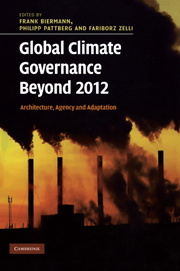Book contents
- Frontmatter
- Contents
- List of contributors
- Preface
- List of abbreviations
- 1 Global climate governance beyond 2012
- Part I Architecture
- Part II Agency
- Part III Adaptation
- 14 Global adaptation governance
- 15 Costs, benefits and interlinkages between adaptation and mitigation
- 16 Global adaptation governance
- 17 Global adaptation governance beyond 2012
- 18 Shaping future adaptation governance
- 19 Conclusions
- Index
- References
16 - Global adaptation governance
the case of protecting climate refugees
Published online by Cambridge University Press: 05 July 2014
- Frontmatter
- Contents
- List of contributors
- Preface
- List of abbreviations
- 1 Global climate governance beyond 2012
- Part I Architecture
- Part II Agency
- Part III Adaptation
- 14 Global adaptation governance
- 15 Costs, benefits and interlinkages between adaptation and mitigation
- 16 Global adaptation governance
- 17 Global adaptation governance beyond 2012
- 18 Shaping future adaptation governance
- 19 Conclusions
- Index
- References
Summary
Introduction
Climate change is likely to cause or increase regional migration, for example when coastal areas are given up because of sea-level rise and more frequent and severe storm surges. The future problem of ‘climate refugees’ is often associated with smaller island states, such as the Maldives or Tuvalu. Indeed, in 2006 the Republic of the Maldives (2006) organized a first meeting of representatives of governments, humanitarian organizations and United Nations agencies on this issue. Yet climate-related migration could also evolve into a much larger, global crisis far beyond threats to a few island nations. According to some estimates, by 2050 more than 200 million people might flee their homes due to climate change (Myers and Kent 1995; Myers 2002; see also the discussion in Stern 2007: ch. 3.5). Such estimates have a large margin of error and depend on underlying assumptions about population growth, economic development, temperature increase or the degree and timing of climate change impacts such as sea-level rise (critically on such estimates see Suhrke 1994: 478; Black 2001: 2–8; Castles 2002: 2–3). Yet most scenarios agree on a general trend: that global warming might force millions of people to migrate to other places.
Most of these climate refugees are likely to come from developing nations (Barnett et al. 2005: 306; Nagy et al. 2006; Warren et al. 2006: 18, 20, 41–42). Most victims of sea-level rise are expected in Asia: 26 million people in Bangladesh and 73 million people from China could be forced to flee their homes because of sea-level rise (Myers 2002: 211). In Africa and to a lesser degree in Latin America many people may also experience flooding (Myers and Kent 1995: 148; Nicholls et al. 1999: 80; Myers 2002: 611; Nicholls 2003: 16; Brooks et al. 2006: 6). For many smaller island states, their very existence may be threatened by sea-level rise (German Advisory Council on Global Change 2006: 46, 50).
- Type
- Chapter
- Information
- Global Climate Governance Beyond 2012Architecture, Agency and Adaptation, pp. 255 - 269Publisher: Cambridge University PressPrint publication year: 2010
References
- 4
- Cited by



